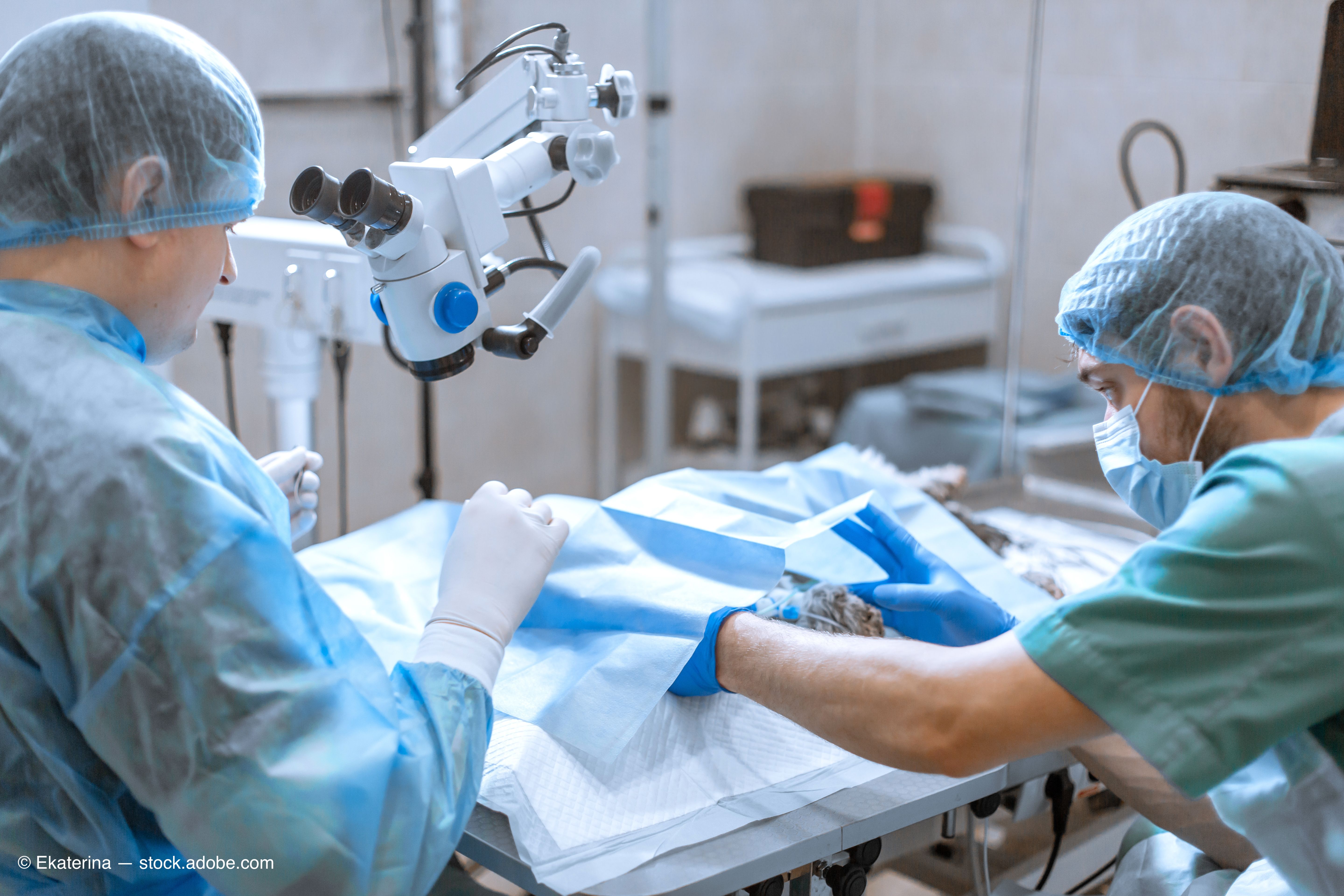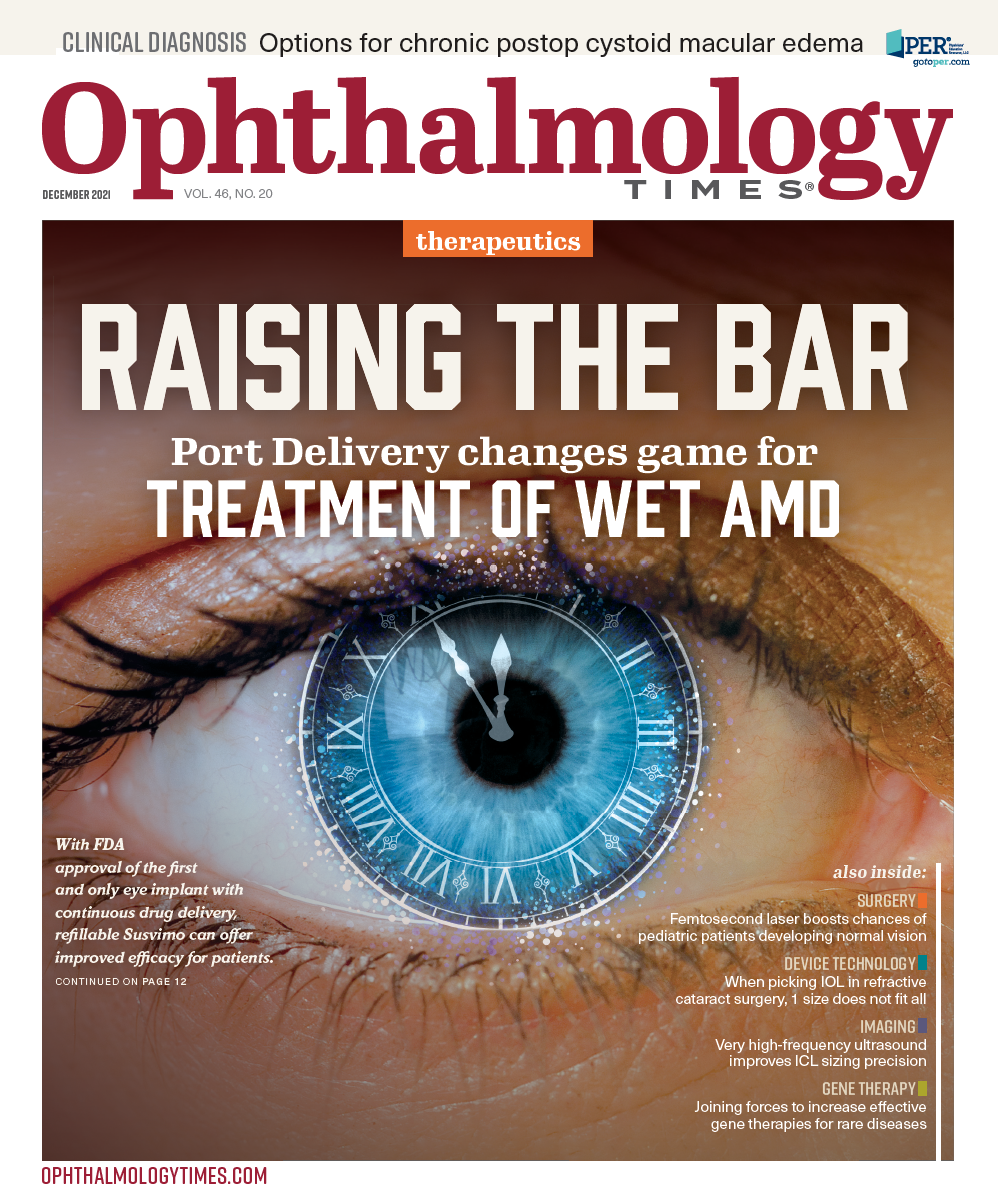Publication
Article
Digital Edition
Weighing treatments for chronic postop cystoid macular edema
Author(s):
Prompt and adequate action is a key to facilitating the best recovery in patients.

Chronic cystoid macular edema (CME) following intraocular surgery is among the most frustrating postoperative complications for patients. A review of risk factors for CME found that approximately 1 in 400 cataract surgeries result in postoperative CME, and eyes with a history of uveitis or that have experienced intraoperative complications during surgery are more likely to develop postoperative CME.1,2
Retina and uveitis specialists are commonly tasked with addressing chronic postoperative CME, and it behooves us to know the latest innovations and management strategies. In this article, I provide an overview of CME’s real world presentation, discuss the pathophysiology of the condition, explore which factors drive treatment decisions, and review options for therapy. I also review 2 cases that illustrate the effects of prompt treatment.
Postoperative CME in the clinic
There is no consensus definition of chronic postoperative CME. In broad terms, chronic postoperative CME occurs when there is evidence of persistent inflammation following intraocular surgery, for at least 6 consecutive months after surgery, and when continued therapy is required to keep such inflammation in check. Therapy includes topical, oral, and intra- or periocular corticosteroids, as well as steroid-sparing immunomodulatory agents.
When evaluating a case of suspected postoperative CME, retina specialists must exclude other entities that might present similarly. Postoperative chronic low-grade endophthalmitis (ie, Propionibacterium acnes endophthalmitis) can present similarly to chronic postoperative CME, and clinicians should look carefully for the presence of capsular plaques and may wish to run the relevant tests to rule out infection.
Related: FDA approves XIPERE for treatment of macular edema associated with uveitis
The positioning of an IOL should be assessed to evaluate for uveitis-glaucoma-hyphema syndrome, which can also contribute to chronic postoperative CME. Anatomical variables such as epiretinal membranes, vitreomacular traction, and traction due to vitreous prolapse to the wound should be assessed. In older patients, there should also be an index of suspicion for masquerade syndromes, such as intraocular lymphoma. It is appropriate to perform a basic uveitis workup in eyes suspected to have chronic postoperative CME, as sometimes there may be an underlying, previously undiagnosed etiology for inflammation which was exacerbated following the intraocular surgery.
Pathophysiology of CME
Short-term inflammation is inevitable following ocular surgery, and for most patients, the standard postoperative topical steroid taper is sufficient to address this inflammation within about a month. In addition to the risk factors outlined above (ie, surgical complications, history of uveitis), glaucoma surgery, longer surgical times, and diabetes place patients at risk for chronic postoperative CME and prolonged recovery.3,4
In patients with chronic postoperative CME, the course is often punctuated by periods of rebound inflammation throughout steroid taper. This chronic inflammation may lead to a persistently compromised blood-ocular barrier. By reestablishing the integrity of the blood-ocular barrier early in the course of CME, ocular immune privilege may be restored, which helps in sustained resolution of inflammation.
Treatment options for modern clinician
Prompt and adequate treatment of chronic CME is key to facilitating patients' recovery. Inadequate treatment, either via underdosing or inadequate duration of dosing, may lead to recurrent CME. This can result in long-term visual decline in a sawtooth pattern, with progressively reduced visual improvement at the zenith despite anatomical improvement, and increased declines at the nadir.5 Moreover, long-term changes to macular anatomy with chronic CME can be seen on OCT imaging, such as disorganization of the inner retinal layers and disruption of the outer retinal layers.6
Local steroid therapy with periocular or intraocular steroids is often the mainstay of treatment of chronic postoperative CME. Systemic immunomodulatory therapy (IMT) may be considered when there are concerns of steroid-induced IOP elevations which can be seen with local steroid delivery. It can also be useful in bilateral cases.
Earlier and more aggressive use of local corticosteroids may, in my experience, lead to reduced duration and severity of postsurgical CME. Some patients experience resolution after a single or a few injections (either intravitreal or sub-Tenon) of local steroids, whereas others require long-term, frequent dosing due to multiple recurrences. When eyes are steroid responsive but require more than 3 to 4 local steroid injections per year for sustained control, I consider the patient to be a candidate for a long-term steroid implant, as long as they have not experienced a steroid-induced IOP elevation.
In my practice, I leverage the fluocinolone acetonide intravitreal implant 0.18 mg (Yutiq, EyePoint Pharmaceuticals) for patients with chronic recurrent postoperative CME whose disease has demonstrated a prior response to steroids and whose IOP is well controlled. I rarely use the surgically placed fluocinolone acetonide intravitreal implant 0.59 mg (Retisert, Bausch + Lomb) in such eyes due to the higher rate of IOP elevation, which may require incisional glaucoma surgery, but it is a valuable tool when there is very severe postoperative inflammation. It is important to counsel patients that rare breakthrough episodes of inflammation may occur despite the placement of a sustained release implant, and that in such cases adjuvant treatment with intravitreal triamcinolone acetonide or the intravitreal dexamethasone implant 0.7 mg (Ozurdex, Allergan) is helpful.
In patients with chronic, recurrent steroid-responsive CME, a long-term steroid implant such as Yutiq allows a reduction in treatment burden and sustained improvement in visual function and long-term preservation of retinal anatomy. It also enables reduced amplitude of fluctuations in retinal thickness as well as an associated saw-tooth functional decline.
Dilraj S. Grewal, MD
E: dilraj.grewal@duke.edu
Grewal has no financial disclosures related to this content.
REFERENCES
1. Patel C, Kim SJ, Chomsky A, Saboori M. Incidence and risk factors for chronic uveitis following cataract surgery. Ocul Immunol Inflamm. 2013:21(2):130-134. doi:10.3109/09273948.2012.752013
2. Llop SM, Papaliodis GN. Cataract surgery complications in uveitis patients: a review article. Semin Ophthalmol. 2018;33(1):64-69. doi:10.1080/08820538.2017.1353815
3. Sobrin L, Pistilli M, Dreger K, et al; Systemic Immunosuppressive Therapy for Eye Diseases Cohort Study Research Group. Factors predictive of remission of chronic anterior uveitis. Ophthalmology. 2020;127(6):826-834. doi:10.1016/j.ophtha.2019.11.020
4. Yang J, Cai L, Sun Z, et al. Risk factors for and diagnosis of pseudophakic cystoid macular edema after cataract surgery in diabetic patients. J Cataract Refract Surg. 2017;43(2):207-214. doi:10.1016/j.jcrs.2016.11.047
5. Jabs DA. Immunosuppression for the uveitides. Ophthalmology. 2018;125(2):193-202. doi:10.1016/j.ophtha.2017.08.007
6. Grewal DS, O’Sullivan ML, Kron M, Jaffe GJ. Association of disorganization of retinal inner layers with visual acuity in eyes with uveitic cystoid macular edema. Am J Ophthalmol. 2017;177:116-125. doi:10.1016/j.ajo.2017.02.017
Newsletter
Don’t miss out—get Ophthalmology Times updates on the latest clinical advancements and expert interviews, straight to your inbox.






